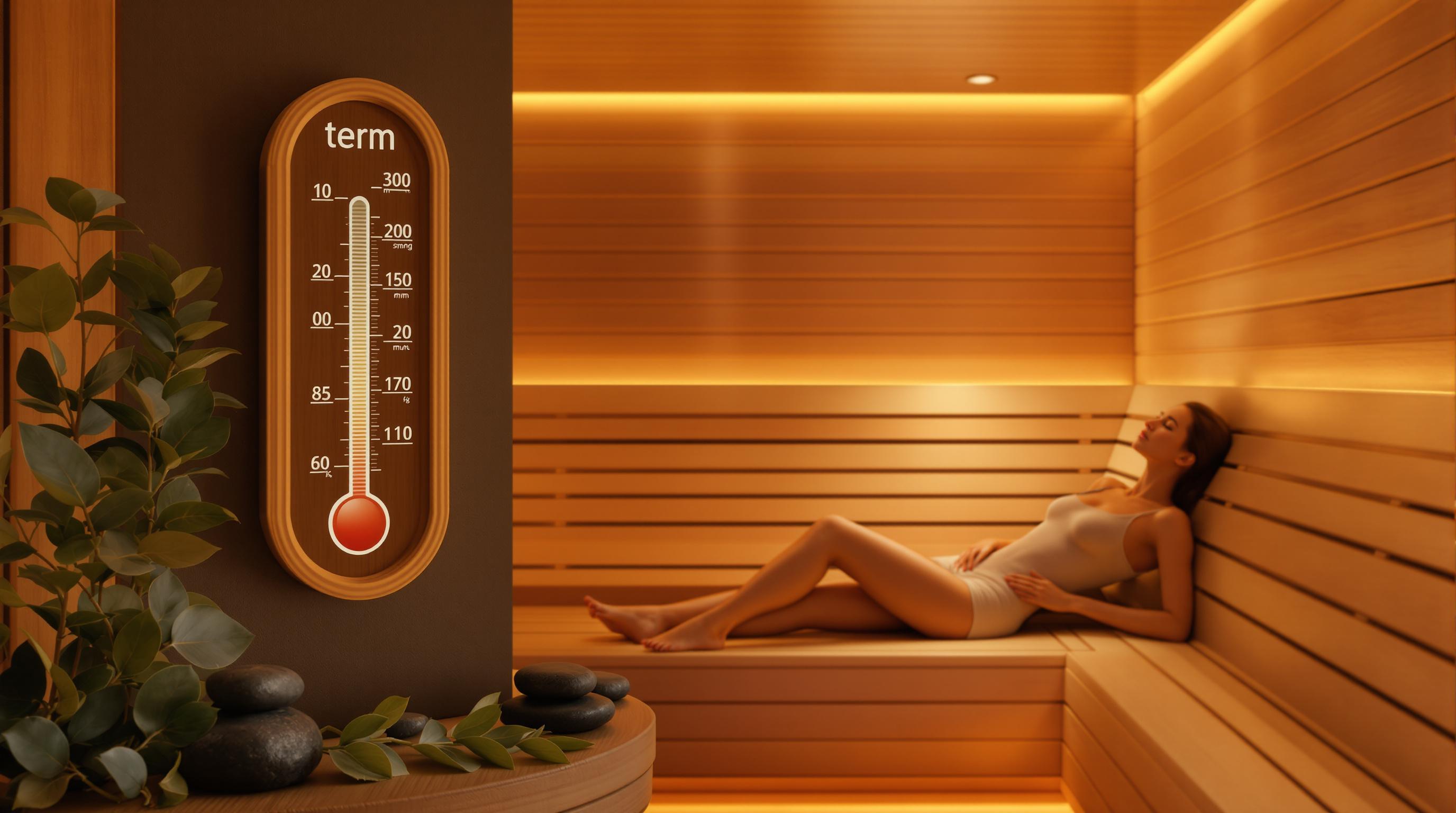Looking to save energy while enjoying sauna benefits? Here's the quick answer:
- Infrared saunas use far less electricity, consuming around 1.75 kWh per session compared to 8.9 kWh per session for steam saunas. This makes them up to 5x more energy-efficient.
- Infrared saunas heat your body directly, operate at lower temperatures (120°F-140°F), and are compatible with solar power. They’re cheaper to run and easier to install.
- Steam saunas, while offering benefits like improved respiratory function and skin hydration, require higher temperatures (150°F-180°F), continuous steam production, and more energy to maintain.
Quick Comparison
| Feature | Infrared Sauna | Steam Sauna |
|---|---|---|
| Energy Use per Session | 1.75 kWh | 8.9 kWh |
| Monthly Cost (Daily Use) | £4-5 | £20-25 |
| Warm-up Time | 10-15 minutes | 35-45 minutes |
| Installation Needs | Basic (DIY possible) | Plumbing required |
| Best For | Energy savings, solar setups | Traditional sauna experience |
If energy efficiency, lower costs, and easy installation matter to you, infrared saunas are the clear winner. But if you prioritize a classic sauna feel with steam and high humidity, go for a steam sauna. Read on to explore how they work, their energy use, and tips for choosing the right sauna for your home.
Infrared Sauna VS Traditional Sauna: What's Best?
How Infrared and Steam Saunas Work
The way infrared and steam saunas generate and deliver heat plays a big role in their energy use, user experience, and operating costs. Their heating methods are key to understanding why their efficiency levels vary so much.
Infrared Sauna Heating Method
Infrared saunas use nearly all their electrical energy to heat the body directly. Unlike steam saunas, they don’t need to heat the entire room. This direct approach allows them to operate at lower temperatures while still promoting intense sweating.
Here’s why infrared saunas are more efficient:
- Direct heating: They warm the body without heating the surrounding air.
- Smart temperature control: They adjust power usage to maintain consistent heat.
- Compact design: Their smaller size reduces heat loss.
Steam Sauna Heating Method
Steam saunas require much more energy because they rely on heating water to produce steam and maintain high humidity levels. They also heat the entire room, which demands constant energy input.
The process for steam saunas involves:
- Generating steam continuously to keep humidity levels high.
- Heating the entire room’s air volume.
- Requiring more power to sustain the environment.
For context, a steam sauna typically uses 10-14 kW of power, whereas an infrared sauna of similar size needs only 4.8 kW [2].
This difference in heating methods is the main reason for the gap in energy consumption, which we’ll explore more in the next section.
Energy Efficiency: Infrared vs. Steam Saunas
Energy Use in Infrared Saunas
Infrared saunas use about 1.75kW/h per session, making them far more energy-efficient. Their direct heating approach ensures almost all the electricity is converted into usable heat. This results in much lower running costs compared to steam saunas [2][3].
Energy Use in Steam Saunas
Steam saunas, on the other hand, consume up to 8.9kW/h per session [2][3]. Despite some modern features designed to save energy, they remain less efficient. The need for continuous steam production, combined with heat loss through ventilation and high power demands, contributes to their higher energy use.
Infrared vs. Steam Sauna: Energy Comparison Table
Here’s a quick look at how the two sauna types compare in terms of energy efficiency:
| Feature | Infrared Sauna | Steam Sauna |
|---|---|---|
| Energy Consumption per Session | 1.75kW/h | 8.9kW/h |
| Monthly Operating Cost* | £4-5 (3-person unit) | £20-25 (comparable size) |
| Warm-up Time | 10-15 minutes | 35-45 minutes |
*Based on one hour of daily use [5]
Infrared saunas stand out as a cost-effective option for home users. Their lower energy needs also make them an excellent match for renewable energy setups, like solar panels [6]. These factors play a major role in their compatibility with sustainable energy solutions, which will be discussed further in the next section.
Using Renewable Energy with Saunas
Solar Power for Infrared Saunas
Infrared saunas are a great match for solar energy due to their low power requirements. A small solar panel setup paired with a battery system is often enough to meet their needs. In fact, a typical residential solar system can handle an infrared sauna along with other household energy demands. Thanks to their efficient energy use, these saunas can operate smoothly even on overcast days by relying on stored solar power instead of grid electricity.
Renewable Energy Storage for Steam Saunas
Steam saunas, on the other hand, require significantly more energy, making renewable integration a bit trickier. However, advanced storage systems can help by saving excess renewable energy for later use, ensuring a more sustainable operation.
Here’s a quick look at some storage options for steam saunas:
| Storage Type | Capacity Range | Ideal For |
|---|---|---|
| Pressurized Water Tanks | 500-2000L | Daily Use |
| Thermal Storage Systems | 5-15 kWh | Heavy Usage |
| Battery Systems | 10-20 kWh | Backup Power |
For consistent performance, steam sauna owners can combine solar power with these storage systems. While the initial investment may be higher, the long-term savings and reduced environmental impact make it worthwhile. Consulting a renewable energy specialist can help you choose the best setup based on your usage habits and local weather conditions.
If you’re focused on reducing your carbon footprint, these renewable options can make a big difference in both cost and environmental impact. Understanding how your sauna fits into a renewable energy system is essential when planning for a more sustainable lifestyle.
sbb-itb-3953eb0
Choosing the Right Sauna for Your Home
Space and Installation Needs
Infrared saunas are compact and straightforward to set up, requiring just a standard electrical outlet and basic ventilation. Steam saunas, however, need more detailed planning since they require dedicated plumbing and advanced ventilation systems.
Here's a quick comparison of what each sauna type needs for installation:
| Feature | Infrared Sauna | Steam Sauna |
|---|---|---|
| Minimum Space | 3x3 feet | 5x5 feet |
| Plumbing Needed | No | Yes |
| Ventilation | Basic | Enhanced |
| Installation Time | 2-4 hours | 1-3 days |
| Professional Install | Optional (DIY possible) | Required (licensed plumber/electrician) |
Energy efficiency is another key factor to think about when it comes to long-term costs.
Energy Costs Over Time
Infrared saunas are much cheaper to run compared to steam saunas, saving frequent users potentially hundreds of dollars each year. Their lower energy use also makes them a great match for homes with renewable energy systems, like solar panels.
Health Benefits of Infrared and Steam Saunas
Both types of saunas bring unique health perks. Infrared saunas are particularly effective for:
- Relieving muscle soreness
- Supporting detox efforts
- Boosting heart health [1]
Steam saunas are better suited for:
- Improving respiratory function
- Hydrating the skin
- Offering a more traditional, relaxing sauna experience [3]
These differences can guide you in choosing the sauna that best matches your wellness goals.
For a deeper dive into sauna options, check out Find the Home Sauna of Your Dreams at tophomesauna.com. Their site lets you filter models based on installation needs, energy usage, and health benefits, making it easier to find the perfect fit.
"Both types of saunas offer health benefits, but infrared saunas are known for their deeper heat penetration, which can lead to more effective detoxification and cardiovascular improvements. Steam saunas, on the other hand, may help with skin health and respiratory issues" [1][3].
Conclusion: Choosing Between Infrared and Steam Saunas
When deciding between infrared and steam saunas, factors like available space, energy usage, and personal wellness goals are key. Infrared saunas stand out for their energy efficiency, using only a fraction of the electricity required by steam saunas.
This efficiency offers practical perks for homeowners. Infrared saunas heat up in just 15-20 minutes, compared to the 30-45 minutes needed for steam saunas. Plus, their lower energy demands make them a great fit for homes with solar power systems, aligning well with eco-friendly living.
Here are some important points to weigh:
- Space and installation needs
- Upfront costs vs. long-term expenses
- Energy use and environmental considerations
"Both infrared and steam saunas offer health benefits, but infrared saunas are known for their deeper heat penetration and more effective detoxification, while using only about a fifth of the electricity consumed by traditional electric saunas" [2][4].
For frequent users, infrared saunas can lead to significant savings on electricity bills - potentially hundreds of dollars each year. Their easier installation and lower operating costs also make them a smart long-term choice compared to steam saunas.
The best sauna for you will depend on your energy preferences, space limitations, and health objectives. If you're ready to dive into specific options, Find the Home Sauna of Your Dreams (tophomesauna.com) offers detailed comparisons to help you choose the perfect fit based on your priorities.
Explore Sauna Options at Find the Home Sauna of Your Dreams

Find the Home Sauna of Your Dreams offers a detailed look at energy-efficient sauna models tailored to your preferences. Their platform is designed to make selecting the right sauna easy, especially if energy savings and renewable compatibility are top priorities.
The platform's filtering tools let users narrow down options based on:
- Energy efficiency ratings and power consumption
- Compatibility with renewable energy systems
- Specific installation requirements
- Power specifications for different setups
Each sauna listing highlights key energy-saving features like:
- Programmable timers and auto-shutoff systems
- Advanced insulation for better heat retention
- Smart temperature controls for precision
- Solar-ready options for compatible models
For those focused on eco-friendly choices, the platform emphasizes saunas built for renewable energy setups. You’ll also find detailed power usage data to estimate operating costs, along with clear installation guides covering electrical and space needs.
Their guides also offer practical advice, such as:
- Tips for using saunas efficiently to save energy
- Maintenance practices to keep performance optimal
- How to connect saunas to renewable energy systems
- Ideas for lowering long-term operating expenses
With easy access to energy consumption details and sustainability features, the platform makes it simple to choose a sauna that fits both your wellness goals and energy-saving plans.
For more information, check out the FAQs section, where you’ll find answers to common questions about power usage, renewable compatibility, and cost considerations.
FAQs
What type of sauna uses the least electricity?
Infrared saunas stand out as the most energy-efficient option compared to steam saunas. They use about 1.75 kWh per session, while traditional electric saunas consume around 8.9 kWh per session [2].
This energy efficiency can lead to noticeable savings. For instance, in commercial settings operating 12 hours a day, facilities have reported savings of up to €1,089 per month [2].
Can you run a sauna off solar panels?
Yes, both infrared and steam saunas can be powered by solar panels, but infrared saunas are especially suited for this due to their lower energy requirements.
Here are some key points to consider for solar-powered saunas:
- Infrared saunas typically require 1.2–2.4 kWh, making them ideal for solar setups [4][2].
- Combining solar panels with an infrared sauna setup can significantly reduce energy costs without sacrificing performance.
- Consulting with solar installation professionals ensures the system is properly sized and compatible with your sauna.
For more tips and detailed comparisons, check out the main sections of this article.


